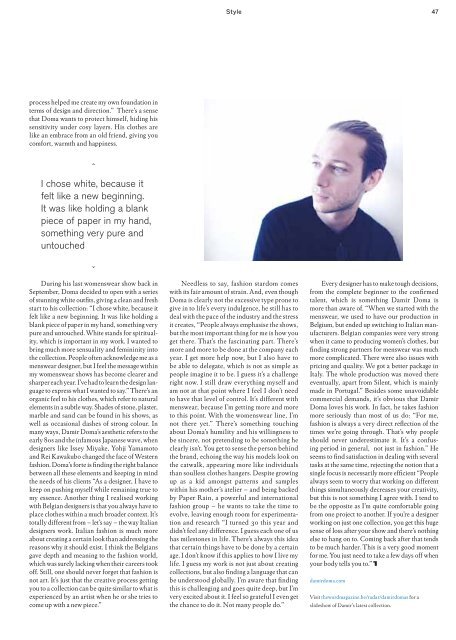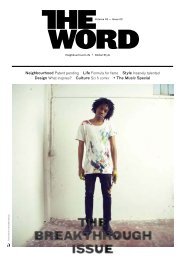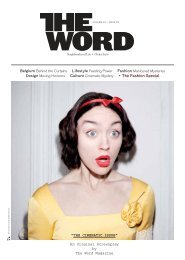Download - The Word Magazine
Download - The Word Magazine
Download - The Word Magazine
Create successful ePaper yourself
Turn your PDF publications into a flip-book with our unique Google optimized e-Paper software.
process helped me create my own foundation in<br />
terms of design and direction.” <strong>The</strong>re’s a sense<br />
that Doma wants to protect himself, hiding his<br />
sensitivity under cosy layers. His clothes are<br />
like an embrace from an old friend, giving you<br />
comfort, warmth and happiness.<br />
ˆ<br />
I chose white, because it<br />
felt like a new beginning.<br />
It was like holding a blank<br />
piece of paper in my hand,<br />
something very pure and<br />
untouched<br />
ˇ<br />
During his last womenswear show back in<br />
September, Doma decided to open with a series<br />
of stunning white outfits, giving a clean and fresh<br />
start to his collection: “I chose white, because it<br />
felt like a new beginning. It was like holding a<br />
blank piece of paper in my hand, something very<br />
pure and untouched. White stands for spirituality,<br />
which is important in my work. I wanted to<br />
bring much more sensuality and femininity into<br />
the collection. People often acknowledge me as a<br />
menswear designer, but I feel the message within<br />
my womenswear shows has become clearer and<br />
sharper each year. I’ve had to learn the design language<br />
to express what I wanted to say.” <strong>The</strong>re’s an<br />
organic feel to his clothes, which refer to natural<br />
elements in a subtle way. Shades of stone, plaster,<br />
marble and sand can be found in his shows, as<br />
well as occasional dashes of strong colour. In<br />
many ways, Damir Doma’s aesthetic refers to the<br />
early 80s and the infamous Japanese wave, when<br />
designers like Issey Miyake, Yohji Yamamoto<br />
and Rei Kawakubo changed the face of Western<br />
fashion. Doma’s forte is finding the right balance<br />
between all these elements and keeping in mind<br />
the needs of his clients “As a designer, I have to<br />
keep on pushing myself while remaining true to<br />
my essence. Another thing I realised working<br />
with Belgian designers is that you always have to<br />
place clothes within a much broader context. It’s<br />
totally different from – let’s say – the way Italian<br />
designers work. Italian fashion is much more<br />
about creating a certain look than addressing the<br />
reasons why it should exist. I think the Belgians<br />
gave depth and meaning to the fashion world,<br />
which was surely lacking when their careers took<br />
off. Still, one should never forget that fashion is<br />
not art. It’s just that the creative process getting<br />
you to a collection can be quite similar to what is<br />
experienced by an artist when he or she tries to<br />
come up with a new piece.”<br />
Style<br />
Needless to say, fashion stardom comes<br />
with its fair amount of strain. And, even though<br />
Doma is clearly not the excessive type prone to<br />
give in to life’s every indulgence, he still has to<br />
deal with the pace of the industry and the stress<br />
it creates, “People always emphasise the shows,<br />
but the most important thing for me is how you<br />
get there. That’s the fascinating part. <strong>The</strong>re’s<br />
more and more to be done at the company each<br />
year. I get more help now, but I also have to<br />
be able to delegate, which is not as simple as<br />
people imagine it to be. I guess it’s a challenge<br />
right now. I still draw everything myself and<br />
am not at that point where I feel I don’t need<br />
to have that level of control. It’s different with<br />
menswear, because I’m getting more and more<br />
to this point. With the womenswear line, I’m<br />
not there yet.” <strong>The</strong>re’s something touching<br />
about Doma’s humility and his willingness to<br />
be sincere, not pretending to be something he<br />
clearly isn’t. You get to sense the person behind<br />
the brand, echoing the way his models look on<br />
the catwalk, appearing more like individuals<br />
than soulless clothes hangers. Despite growing<br />
up as a kid amongst patterns and samples<br />
within his mother’s atelier – and being backed<br />
by Paper Rain, a powerful and international<br />
fashion group – he wants to take the time to<br />
evolve, leaving enough room for experimentation<br />
and research “I turned 30 this year and<br />
didn’t feel any difference. I guess each one of us<br />
has milestones in life. <strong>The</strong>re’s always this idea<br />
that certain things have to be done by a certain<br />
age. I don’t know if this applies to how I live my<br />
life. I guess my work is not just about creating<br />
collections, but also finding a language that can<br />
be understood globally. I’m aware that finding<br />
this is challenging and goes quite deep, but I’m<br />
very excited about it. I feel so grateful I even get<br />
the chance to do it. Not many people do.”<br />
47<br />
Every designer has to make tough decisions,<br />
from the complete beginner to the confirmed<br />
talent, which is something Damir Doma is<br />
more than aware of. “When we started with the<br />
menswear, we used to have our production in<br />
Belgium, but ended up switching to Italian manufacturers.<br />
Belgian companies were very strong<br />
when it came to producing women’s clothes, but<br />
finding strong partners for menswear was much<br />
more complicated. <strong>The</strong>re were also issues with<br />
pricing and quality. We got a better package in<br />
Italy. <strong>The</strong> whole production was moved there<br />
eventually, apart from Silent, which is mainly<br />
made in Portugal.” Besides some unavoidable<br />
commercial demands, it’s obvious that Damir<br />
Doma loves his work. In fact, he takes fashion<br />
more seriously than most of us do: “For me,<br />
fashion is always a very direct reflection of the<br />
times we’re going through. That’s why people<br />
should never underestimate it. It’s a confusing<br />
period in general, not just in fashion.” He<br />
seems to find satisfaction in dealing with several<br />
tasks at the same time, rejecting the notion that a<br />
single focus is necessarily more efficient “People<br />
always seem to worry that working on different<br />
things simultaneously decreases your creativity,<br />
but this is not something I agree with. I tend to<br />
be the opposite as I’m quite comfortable going<br />
from one project to another. If you’re a designer<br />
working on just one collection, you get this huge<br />
sense of loss after your show and there’s nothing<br />
else to hang on to. Coming back after that tends<br />
to be much harder. This is a very good moment<br />
for me. You just need to take a few days off when<br />
your body tells you to.”<br />
damirdoma.com<br />
Visit thewordmagazine.be/radar/damirdomas for a<br />
slideshow of Damir’s latest collection.
















